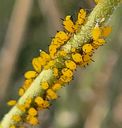Oleander Aphid
Aphis nerii
Classification
- Phylum: Arthropoda
- Subphylum: Hexapoda
- Class: Insecta
- Order: Hemiptera
- Suborder: Sternorrhyncha
- Superfamily: Aphidoidea
- Family: Aphididae
- Subfamily: Aphidinae
- Tribe: Aphidini
- Subtribe: Aphidina
- Genus: Aphis
- Species: nerii
Pronunciation
How to pronounce Aphis nerii: //ˈeɪfɪs ˈnɪəri.aɪ//
These audio files are automatically generated. While they are not always 100% accurate, they are a good starting point.
Images






Summary
Aphis nerii, commonly known as the oleander aphid, is a small yellow-orange aphid that feeds primarily on plants in the dogbane family, especially oleander and milkweed. It is a vector for several plant viruses and is known for its viviparous reproduction.
Physical Characteristics
1.5-2.6 mm; Yellow-orange with black cornicles, legs and antennae; alate forms have pigmented thorax.
Identification Tips
Adults can be winged or wingless; presence of black cornicles and yellow-orange coloration are key identifiers.
Habitat
Regions with tropical and Mediterranean climates; occasionally present in glasshouses.
Distribution
Originally native to the Mediterranean, now cosmopolitan; introduced to North America with its host plant, Nerium oleander.
Diet
Feeds on the sap of plants in the dogbane family (Apocynaceae), particularly on oleander, milkweed, and periwinkle; known to feed on over 50 hosts including multiple plant families.
Life Cycle
Aphis nerii reproduces viviparously, producing live young (nymphs). The species is predominantly parthenogenetic, with males rarely observed in the wild. Winged forms are produced when migration is necessary.
Reproduction
Viviparous reproduction; parthenogenetic with female-only populations; males have been created in laboratory settings.
Predators
Predators include larvae of lacewings and lady beetles, syrphid flies, and parasitic wasps.
Ecosystem Role
Aphis nerii acts as both a herbivore and a virus vector, affecting plant health and facilitating the transmission of certain viral diseases.
Economic Impact
Impacted by acting as a vector for multiple plant viruses that can affect agricultural crops.
Cultural Significance
Commonly known as oleander aphid, milkweed aphid, sweet pepper aphid, and nerium aphid; has significance in gardening and horticulture due to its host preferences.
Evolution
Adapted to a wide range of host plants and environments; has evolved forms (winged and wingless) based on environmental pressures.
Similar Taxa
Misconceptions
Often confused with other aphid species; some might overestimate the impact of individual aphids in agricultural contexts.
Tags
- Oleander Aphid
- Aphidoidea
- Milkweed
- Herbivore
- Virus Vector